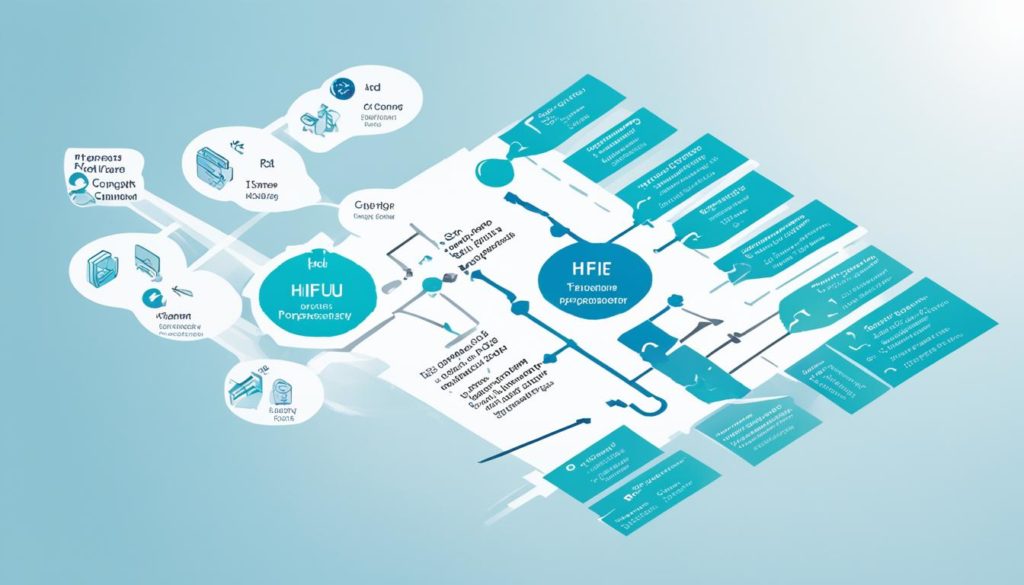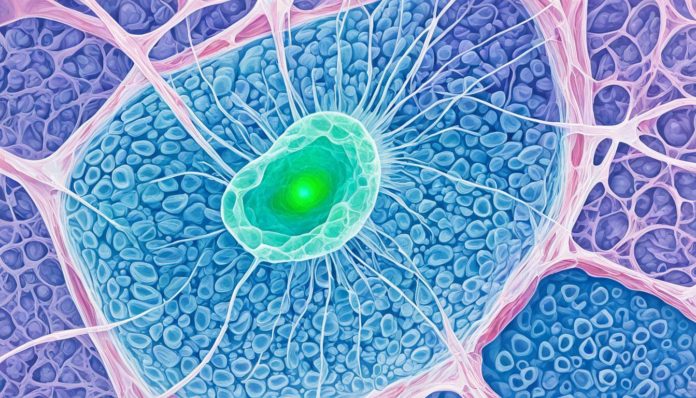Did you know that over 174,000 men in the United States get prostate cancer every year? This high number makes the search for effective and non-invasive treatments vital for both doctors and patients. High-Intensity Focused Ultrasound (HIFU) therapy is becoming a popular choice in managing prostate cancer. Dr. Derek J. Lomas, M.D., Pharm.D., at Mayo Clinic, has pointed out how well HIFU works. It targets prostate tissue while keeping side effects low. For those looking for a gentler approach, HIFU could be a game-changer alongside traditional treatments.
Key Takeaways
- HIFU is emerging as an effective, non-invasive prostate cancer treatment.
- Mayo Clinic’s Dr. Derek J. Lomas underscores the low side effects of HIFU therapy.
- This treatment presents a new avenue in prostate cancer management for patients.
- Over 174,000 men in the U.S. are diagnosed with prostate cancer annually.
- HIFU therapy is important for those seeking less invasive treatment options.
Understanding HIFU: A Revolutionary Approach to Prostate Cancer Treatment
Prostate cancer alternative treatment options are evolving. High-intensity focused ultrasound for prostate cancer is one of the most promising advancements.

What is HIFU?
High-intensity focused ultrasound, known as HIFU, is cutting-edge technology. It’s used as an alternative treatment for prostate cancer. This procedure uses high-frequency sound waves to target and kill cancer cells in the prostate.
Unlike traditional methods, HIFU is non-invasive. This means it reduces the need for surgery, cuts down risks, and shortens recovery time.
How does HIFU work?
The HIFU cancer treatment directs ultrasound waves into the prostate. These waves create intense heat, killing cancer cells without harming healthy tissue. The procedure is guided by real-time imaging for precision and effectiveness.
HIFU is a great option for treating prostate cancer. It’s often suggested for patients with localized or recurrent prostate cancer. This targeted approach reduces side effects and helps patients recover faster.
The Evolution of HIFU in Prostate Cancer Treatment
HIFU’s journey in prostate cancer has been a game-changer. Over the years, HIFU has become a key player in fighting prostate cancer. It offers a less invasive option, which has helped many patients see better results.
A Brief History of HIFU
HIFU started to make waves in the mid-1990s with its first clinical trials for prostate cancer. The first results were positive. This success led to its gradual acceptance in treating the disease. By the 2000s, HIFU was gaining worldwide recognition, becoming a critical part of advanced prostate cancer care.
Clinical Trials and Studies
Research into HIFU for prostate cancer has proven its worth by showing how safe and effective it is. Initial studies worked to fully grasp what HIFU could do. Later research focused on making sure it worked as well as possible. The move towards focusing treatment on just the cancer areas has been key. It aims to lower side effects while fighting cancer effectively.

| Phase | Focus | Outcomes |
|---|---|---|
| 1990s | Initial Clinical Trials | Promising Tissue Ablation Results |
| 2000s | Clinical Practice Adoption | Widespread Global Acceptance |
| 2010s | Advanced Studies on Focal Therapy | Reduced Side Effects and Increased Efficacy |
Research on HIFU is still going strong, aiming to make it even more precise and effective for prostate cancer. This ongoing innovation keeps HIFU in the lead as a top treatment option.
Who is an Ideal Candidate for HIFU Prostate Cancer Treatment?
Figuring out the best fit for HIFU means a deep review to see if it’s right for prostate cancer. This process picks out patients who match specific health guidelines. It aims for the best results and safety for the patient.
Criteria for HIFU candidacy
Finding the right HIFU patient depends on a few key points. First off, they usually have a type of prostate cancer that’s not too aggressive and only in one part of the prostate. This is often confirmed with MRI scans and biopsies. Also, the cancer needs to be in a spot where HIFU can reach it well.
Case studies
Looking at real cases helps understand who benefits from HIFU for prostate cancer. People with cancer only in one place, not too severe symptoms, and no previous treatments respond well to HIFU. Studies with patients highlight that HIFU works great on tumors in certain prostate areas, showing it’s a solid choice for some.
HIFU Procedure: What to Expect
Understanding HIFU treatment is key for patients ready to try this new prostate cancer treatment. This part explains the steps and what patients can look forward to during the HIFU journey.
Pre-treatment preparations
Getting ready for HIFU involves a few important steps. Patients need to make sure their bowels are empty and fast for a certain time before the procedure. This helps make the treatment area clear and lowers the chance of any problems during HIFU.
The HIFU treatment process
Patients are given general anesthesia, so they won’t feel pain during HIFU. A probe is used to send ultrasound waves right to the prostate. These waves heat up and destroy the cancer cells. The treatment is not invasive, takes a few hours, and you can usually go home the same day.
Post-treatment recovery
After treatment, patients might need to use a urinary catheter for a while. You may have some mild urinary issues, but they usually get better quickly. Following recovery tips is important for getting back to normal life. HIFU’s recovery time is shorter compared to traditional treatments, making it a great option.
Benefits of HIFU for Prostate Cancer
HIFU offers many benefits for treating prostate cancer, making it an attractive option. It uses High-Intensity Focused Ultrasound, setting it apart from older treatments. Its key benefits include being less invasive, having fewer side effects, and quick recovery.
Minimally Invasive Nature
HIFU for prostate cancer means less cutting. It doesn’t need big surgeries like a prostatectomy does. Instead, it uses ultrasound waves to kill cancer cells. There’s no need to make incisions.
Reduced Side Effects
HIFU has fewer nasty side effects compared to other treatments. Traditional methods often lead to problems like incontinence and a lack of sexual function. But HIFU carries a lower risk, helping patients maintain a better life after treatment.
Shorter Recovery Time
Recovering from HIFU takes less time. This is a big plus when compared to recovery from surgeries. Patients can get back to their normal lives sooner. This quick comeback is why many choose HIFU for fighting prostate cancer.
Comparing HIFU to Other Prostate Cancer Treatments
When looking at treatments for prostate cancer, it’s important to weigh High-Intensity Focused Ultrasound (HIFU) against other methods. These include radical prostatectomy and radiation therapy. Each one offers unique benefits and some drawbacks. This is why making an informed choice is key for the best results.
HIFU vs. Radical Prostatectomy
HIFU and prostatectomy have big differences, especially in how invasive they are. Prostatectomy involves removing the prostate, leading to a tough recovery. It can cause issues like urinary problems and trouble with sexual function. HIFU, meanwhile, uses ultrasound to target cancer cells directly. This usually means less recovery time and fewer side effects.
HIFU vs. Radiation Therapy
Looking at HIFU and radiation for prostate cancer shows important contrasts. Radiation uses high-energy beams to attack cancer, which can cause long-term problems such as bowel issues and tiredness. HIFU targets only the cancer cells, sparing healthy tissue. This means patients often have a better life after treatment, without the harsh effects of radiation.
HIFU stands out when comparing it to other treatments because it’s less invasive with a different risk profile. It’s a good option for many patients facing prostate cancer.
| Treatment Type | Invasiveness | Common Side Effects | Recovery Time |
|---|---|---|---|
| HIFU | Non-invasive | Minimal | Short |
| Radical Prostatectomy | Invasive | Urinary incontinence, erectile dysfunction | Long |
| Radiation Therapy | Non-invasive | Bowel issues, fatigue | Varies |
Understanding the Side Effects and Risks of HIFU Therapy
High-intensity focused ultrasound (HIFU) therapy offers a less invasive option for treating prostate cancer. Still, it carries possible side effects and risks. It’s vital for patients to be aware of these before choosing this treatment.
Common side effects
HIFU has fewer side effects than traditional methods, but issues can arise. Patients might face:
- Temporary urinary obstruction
- Potential erectile dysfunction, especially if treatment affects erectile nerves
- Infections needing more medical care
Most side effects of HIFU are temporary. For more details, patients can check studies on WebMD.
Long-term risks
Long-term risks from HIFU could affect one’s life significantly:
- Lasting incontinence, impairing urinary control
- Erectile dysfunction needing further treatments
These risks are less common than with old-style treatments. For latest findings, visit WebMD.
Knowing the risks and side effects of HIFU helps in choosing the right prostate cancer treatment. This knowledge ensures one considers the pros and cons carefully.
HIFU Treatment Success Rate and Outcomes
High-Intensity Focused Ultrasound (HIFU) is gaining popularity in treating prostate cancer. Thanks to technology, HIFU is a less invasive option compared to older methods.
Clinical Success Rates
Studies show HIFU has a high success rate in controlling prostate cancer. Research shows it’s effective in destroying cancer cells. It also targets the prostate accurately, protecting nearby healthy tissue.
Patients face fewer side effects after surgery. This proves HIFU’s effectiveness in treating prostate cancer.
Patient Testimonials
People treated with HIFU often share positive experiences. They talk about better life quality after treatment. Here’s what they say:
“The recovery was swift and less painful compared to my initial expectations.”
“Choosing HIFU allowed me to return to my daily activities without significant downtime.”
This feedback gives hope to others thinking about HIFU. It shows how beneficial this treatment can be.
| Treatment | Success Rate | Recovery Time | Side Effects |
|---|---|---|---|
| HIFU | Over 90% | Short | Low |
| Radical Prostatectomy | 85-90% | Longer | Moderate to High |
| Radiation Therapy | 80-85% | Moderate | High |
HIFU stands out for its effectiveness and minimal side effects. It’s as good or even better than older methods. Plus, it has a quicker recovery time.
The Cost of HIFU Prostate Cancer Treatment
The cost of HIFU for prostate cancer varies based on the treatment center and where it is located. Looking into HIFU treatment insurance coverage helps in planning your budget.
Average Cost in the United States
In the United States, HIFU for prostate cancer costs between $15,000 and $25,000 on average. This includes meetings before the treatment, the procedure itself, and care afterwards. It is vital to check with various centers to get a full cost estimation.
Insurance Coverage and Financial Assistance
Finding good HIFU treatment insurance coverage can be tough. Many insurers offer little to no coverage for HIFU. But, there’s hope as the first approvals for insurance coverage have been seen in the United States. This marks a step forward for this new treatment. There are also multiple sources of financial assistance for HIFU, including:
- Payment plans from medical centers
- Third-party financing
- Non-profits offering grants for cancer treatment
Patients should look into all options to help with the costs of HIFU treatment.
Finding the Best HIFU Treatment Center
Finding the right HIFU treatment center is key for good prostate cancer therapy results. It’s important to think about several things when looking for locating HIFU treatment places. This ensures you pick a center that’s well-known and effective.
First, looking at the experience and skills of the medical team is critical. Centers with experienced healthcare professionals in HIFU treatments are more likely to get better results.
Then, think about the advanced technology available. Top HIFU centers have the newest technology. This helps make treatment more precise and effective. Ask about the equipment and methods used at the centers.
Also, consider how much the center focuses on patient-focused care. Centers that offer detailed care, including pre-treatment meetings, personalized treatment plans, and after-care, often provide better experiences and results for patients.
To pick the best prostate cancer HIFU centers, look at these points:
- Medical Team Expertise
- Technological Advancements
- Patient-Centric Services
With careful research on these areas, you can confidently find the best HIFU treatment center for your needs.
Conclusion
HIFU therapy stands out as a promising way to treat prostate cancer, especially for those wanting to keep a good quality of life. It hits the cancer directly without harming much else, leading to quicker healing and fewer bad effects. This less harsh option is appealing compared to tough treatments like surgery and radiation.
HIFU technology has advanced a lot and is now a groundbreaking way to fight prostate cancer. Studies and stories from patients prove it works well, making more people trust it. As it gets better and more accessible, HIFU could become a common choice for treatment, bringing new hope to many.
In short, HIFU is a big leap in treating prostate cancer. Its perks, like being less harsh and having a quicker recovery, show it could change standard cancer care. With ongoing research and positive feedback from patients, HIFU’s future seems very promising. It suggests a major change in treating prostate cancer soon.
FAQ
What is HIFU?
HIFU stands for High-Intensity Focused Ultrasound. It’s a medical process that uses sound waves to heat and eliminate cancer cells in the prostate. This approach is a non-invasive option compared to traditional prostate cancer treatments.
How does HIFU work?
HIFU targets a specific prostate area with ultrasound waves. These waves increase the temperature of the tissue, destroying the cancerous cells. This method precisely removes cancer while keeping healthy tissues safe.
What is the history of HIFU in prostate cancer treatment?
The first clinical trials for HIFU in treating prostate cancer started in the mid-1990s. These trials proved it could successfully target cancer tissues. Since then, HIFU has been used globally, fitting into treatment plans that focus on reducing side effects.
Who is an ideal candidate for HIFU prostate cancer treatment?
The best patients for HIFU usually have prostate cancer that has not spread. Their cancer should be in a part of the prostate that’s easy to reach. A combination of MRI and biopsy helps find the right patients for this treatment.
What should patients expect during the HIFU procedure?
During HIFU, patients undergo a non-invasive treatment that requires general anesthesia. It’s done using a probe and patients must prepare beforehand. After the procedure, patients might use a catheter and will deal with some urinary symptoms for a short period.
What are the benefits of HIFU for prostate cancer?
HIFU has many advantages. It’s less invasive and has fewer side effects like incontinence or erectile problems. Also, patients enjoy a quicker return to their daily lives compared to more traditional treatments.
How does HIFU compare to other treatments for prostate cancer?
Compared to surgeries or radiation, HIFU is less harmful. It typically leads to fewer complications. This helps patients keep living their life with less disruption. HIFU is a good choice for those looking for effective treatment with fewer side effects.
What are the common side effects and risks of HIFU therapy?
After HIFU, some might face temporary urinary problems or erection issues. Very rarely, a severe issue like a rectal fistula can happen. The main long-term concerns are ongoing incontinence or erectile dysfunction, which might need more treatment.
What is the success rate of HIFU treatment?
Many studies and patients report positive results from HIFU. They highlight successful cancer control and better life quality post-treatment. Overall, HIFU shows promising success rates.
What is the cost of HIFU for prostate cancer treatment in the United States?
The price of HIFU can differ greatly. Sometimes insurance might not cover it. But there’s a growing trend of insurance companies offering some level of coverage for HIFU, making it more accessible for patients.
How do I find the best HIFU treatment center?
Look for a HIFU center with lots of experience, cutting-edge technology, and a commitment to patient care. These qualities ensure you receive the best possible treatment.


